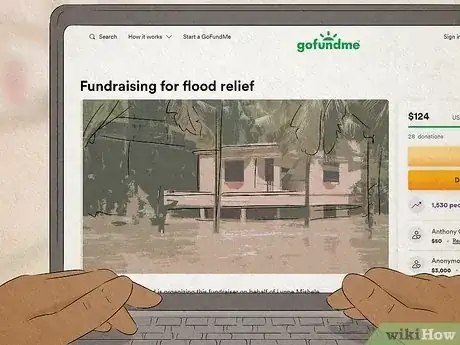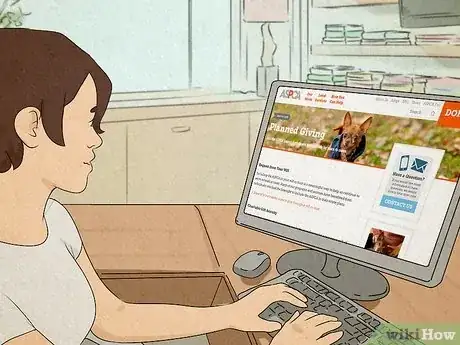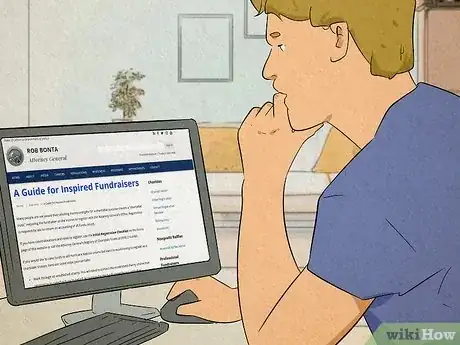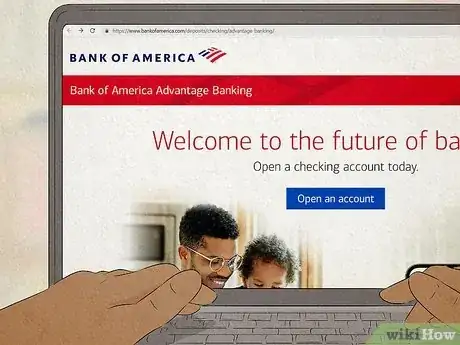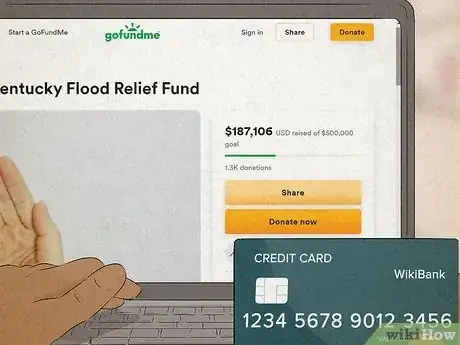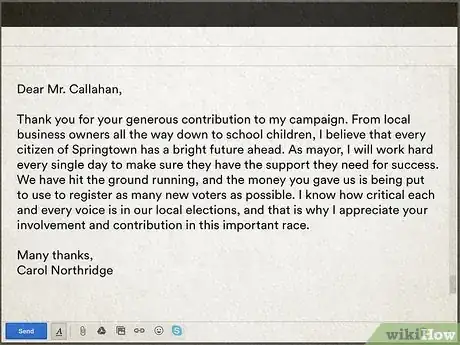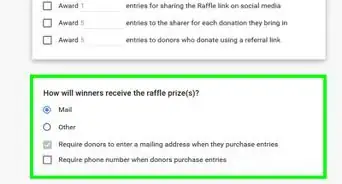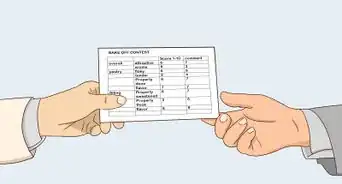This article was co-authored by Direct Relief and by wikiHow staff writer, Aly Rusciano. Direct Relief is an award-winning humanitarian aid organization, active in all 50 states and more than 80 countries. They focus on helping people affected by emergencies and natural disasters. Direct Relief has been highly rated by Charity Navigator, GuideStar, and the Center for High Impact Philanthropy at University of Pennsylvania, for their effectiveness, efficiency, and transparency.
There are 7 references cited in this article, which can be found at the bottom of the page.
wikiHow marks an article as reader-approved once it receives enough positive feedback. In this case, 80% of readers who voted found the article helpful, earning it our reader-approved status.
This article has been viewed 228,676 times.
Is there a cause or charity close to your heart you want to raise money for? Well, you’ve come to the right place! Starting a fundraiser is a great way to spread the word and raise money for something you care about. In this article, we’ll share with you the best ideas, tips, and tricks for fundraising. Grab a pencil and paper or computer and thinking cap—we’ve got some advocacy work to do!
Things You Should Know
- Consider holding a more traditional fundraiser or something virtual, depending on potential donator demographics.
- Start your fundraiser with a well-researched cause you're passionate about.
- Set goals, advertise, and have fun when planning your fundraiser.
Steps
Fundraising Ideas
-
1Reach a wide range of donators with classic fundraisers. Sometimes, a classic lemonade stand or car wash can do the trick. Classic fundraisers are rather simple and generally take little time to set up. If you’re fundraising with a large, diverse group, consider one of these fundraiser ideas:[1]EXPERT TIPDirect Relief is an award-winning humanitarian aid organization, active in all 50 states and more than 80 countries. They focus on helping people affected by emergencies and natural disasters. Direct Relief has been highly rated by Charity Navigator, GuideStar, and the Center for High Impact Philanthropy at University of Pennsylvania, for their effectiveness, efficiency, and transparency.Humanitarian Aid Organization

 Direct Relief
Direct Relief
Humanitarian Aid OrganizationGet the kids involved. According to Direct Relief, even children can contribute to a charity they support. "We've had kids create lemonade stands, bake sales, and even donate their Christmas money. They've found incredible ways to support causes and it really reinvigorates everyone's belief in humanity when you see a kid doing something like that."
-
2Host a competition to raise money. Who doesn’t get riled up and excited about the opportunity to compete? Consider having your fundraiser centered around a contest where all the proceeds go towards your cause, charity, or organization. Check out these fun and competitive fundraising ideas:[2]
- Cooking or baking contests allow people to show off their skills while drawing in a crowd.
- Sporting events like marathons and basketball games are extremely popular with crowds, and concessions can be sold for added donations.
- Karaoke contests are super fun and engaging for all ages.
- Eating competitions like hot dog and watermelon eating contests get participants and crowds excited.[3]
- Obstacle courses prove to be a fun challenge for adults and kids, especially if you team age groups against one another.
- Trivia nights are suitable for all ages and questions can even be themed around your cause.
Advertisement -
3Dare participants to try a challenge to raise more money. Every fundraiser needs a goal, so how about making that goal a specific “reward” for participants? Base your fundraiser around a dare or appearance-altering event to motivate people to donate. If you reach a specific number of donations, you’ll do something wild! Here are some examples:[4]
- Shave your head
- Jump into a freezing lake
- Get a tattoo
- Wear a silly costume for a day
- Dye your hair a wacky color
- Eat something disgusting
-
4Center your campaign around a holiday or season. Get donators into the festive spirit by hosting a fundraiser that’s full of holiday games, prizes, food, and more! This is perfect for when a holiday is just around the corner or your cause helps people during a specific season.
- Gift wrapping
- Easter egg hunt
- Kissing booth
- New Year’s Eve party or raffle
- Trick-or-Treating
- Tailgating party
-
5Start a crowdfunding campaign. There are a ton of websites that’ll help you create a fundraising campaign for practically any cause. Anyone that visits the page can donate whatever amount they'd like. You can even create different tiers of donations, with each tier having a special reward or prize! Simply set up your page with a catchy or compelling description of your cause, and advertise it around social media. Consider using one or these platforms for your campaign:
Fundraising Logistics
-
1Believe in your cause. The key to any money-raising event or fundraiser is genuinely believing in the cause you’re supporting and/or advocating. Do your homework and research facts and statistics. Prepare yourself to get personal and share why the cause means so much to you. The more knowledge and personal involvement you have with a cause, the more likely people are to contribute.[5]
- Your goal as the head of your fundraiser is to make people believe in your cause.
-
2Research the charity or organization you want to support. Before asking for donations, make sure the money goes to the best place possible. Unfortunately, there are scams out there that’ll trick you into sending them donation money. Do a thorough online search of your cause and the organization or charity you want to fundraise for. If you align with the charity or organization’s mission and they have raving reviews, you’re golden! If they have a questionable website or are a part of controversies, consider picking a different charity or organization to support.[6]
- Consider contacting the charity or organization directly or checking out their website for fundraising tips, tricks, and guidelines.
EXPERT TIPDirect Relief is an award-winning humanitarian aid organization, active in all 50 states and more than 80 countries. They focus on helping people affected by emergencies and natural disasters. Direct Relief has been highly rated by Charity Navigator, GuideStar, and the Center for High Impact Philanthropy at University of Pennsylvania, for their effectiveness, efficiency, and transparency.Humanitarian Aid Organization
 Direct Relief
Direct Relief
Humanitarian Aid OrganizationSupport a charity that means something to you. Direct Relief, a humanitarian aid organization, says: "Start by thinking about what matters to you. Then, to find a good charity that's working to address that issue or that cause, ask people you trust for recommendations. You can also go online to websites like Charity Navigator, Charity Watch, or the Better Business Bureau, and look for organizations that are highly rated on those sites."
-
3Review your state's regulations or rules. Most states have specific rules for setting up a fundraiser. Different forms may need to be filled out, and you might need to pay taxes depending on your cause or location. Head to your local county and state’s government websites to access fundraising guidelines for your area.
- Try searching something like “Alabama fundraising guidelines.”
- If you have specific questions or concerns, reach out to local leaders or non-profits for advice.
-
4Get to know your audience. Before you start fundraising, get a feel for what types of donors you want to attract. Is this a fundraiser to help kids, a minority, or a local business? A fundraiser should captivate and intrigue a potential donator enough to donate and support the cause.[7]
- For instance, if you’re raising money for childhood cancer, having a bouncy castle or carnival games at your fundraiser can help attract families.
- If you’re working with an older crowd, a bingo fundraiser could be a fun yet causal idea.
- Consider reviewing the attendance and donation records of the cause from previous fundraisers. Look at the demographics and brainstorm how you can continue to appeal to them.
-
5Ask friends and local communities to help. Running a fundraiser is fun, but it’s even more fun when you do it with friends! Reach out to those in your community who’d be willing to support the cause. Maybe that’s your church group, basketball team, or colleagues. Remember, teamwork makes the dream work![8]
- Post about your fundraising idea on Facebook, Instagram, and other social media platforms to see if any of your friends would be interested in volunteering or helping out.
- Consider building a fundraising team and assigning different goals and tasks to each member. This can help things run smoothly, especially if you’re hosting a large event or campaign.
- For instance, your team might have a social media manager, photographers, public relations manager, and community outreacher.
Fundraising Tips & Tricks
-
1Make goals for your fundraiser. A fundraising plan is necessary for all successful fundraisers. Think about your goals by asking yourself, “How much money do I want to raise? How many people will be at my event? How should people feel leaving my event?” Write these goals down and reference them as you plan for the event, reminding yourself of your core objectives.
- Aim big when making your money-raising goal. Even if you don’t hit the mark, you’re bound to make a difference.[9]
-
2Advertise your fundraiser. Spread the word once you’ve established a plan. How you advertise will depend on your audience—try paper flyers for older demographics and social media posts for younger demographics. Send invitations, call friends, hand out flyers at the store, or make a YouTube video. Do whatever you can to spread the word and get people talking about your cause and campaign![10]
- Consider making social media pages specifically for your campaign. Here you can post updates and pictures and repost the event's hashtags.
-
3Let people know exactly where their money is going. Grab potential donators' attention by stating how their money can help those in need. If you’re upfront about where their donation goes, they’ll be more likely to donate. For example, if $5 purchases 1 vaccination for a child in need, put “$5 = 1 Vaccine” on the campaign advertisements.
- Remember, even the smallest donation can make a big difference!
-
4Consider setting up a fundraising bank account. Local banks can work with you to set up a fund your donors can contribute to. This type of accoun is best used when you’re fundraising for an individual or small group of people. Stop by your local bank and ask about creating a bank account for your event. The banker will be able to assist and inform you on the policies for your bank and area.[11]
- A fundraising bank account needs a beneficiary, whether that’s you or the person/family you’re donating to.
- The beneficiary may need to be present when opening the account to sign notarization forms.
-
5Make donating as easy as possible. The easier it is for passersby to donate to your cause, the more money you'll likely raise. If you have a website to collect donations, ensure it’s easy to navigate and has clear instructions. If you've set up an account at the local bank, make sure the directions for making a deposit are easy to understand.
-
6Host the fundraiser and have fun. Once you’ve planned the logistics of your fundraiser, it’s time to get it started! Arrive to your event early with your team to make sure everything’s ready to go. Then, all that’s left to do is advocate, communicate, and marvel in what you’ve created.
-
7Thank your donors by writing a personal letter or email. Collect the names and addresses or emails of everyone who donates, so that at the end of the campaign or event, you can send them a personal “thank you.” This small act of kindness shows your appreciation and gratitude for any and all donations. Plus, a donor may be more likely to donate to another cause if you prove to be such an incredible fundraising host and/or advocate.[12]
- Try sending out your letters or emails within 48 hours of the fundraiser’s closing.
References
- ↑ https://www.cancerresearchuk.org/get-involved/do-your-own-fundraising/fundraising-ideas
- ↑ https://blog.udemy.com/non-profit-fundraising-ideas/
- ↑ https://www.cancerresearchuk.org/get-involved/do-your-own-fundraising/fundraising-ideas
- ↑ https://www.cancerresearchuk.org/get-involved/do-your-own-fundraising/fundraising-ideas
- ↑ https://www.theguardian.com/money/us-money-blog/2014/jan/21/raise-money-fundraising-polite-guide-strategies
- ↑ https://www.usa.gov/donate-to-charity
- ↑ https://thefundraisingauthority.com/fundraising-basics/fundraising-event/
- ↑ https://www.arthritis.org/getmedia/314ce0ed-0ae7-439b-964b-a43a27f1129e/WTCA-Participant-How-to-fundraise.pdf
- ↑ https://www.arthritis.org/getmedia/314ce0ed-0ae7-439b-964b-a43a27f1129e/WTCA-Participant-How-to-fundraise.pdf
About This Article
If you want to raise money for a good cause, try hosting a classic fundraiser like a bake sale, party, or car wash. They tend to be easy and relatively successful, making them good choices. But if you are targeting a younger demographic, you may do better starting a crowdfunding campaign. Once you’ve decided on a fundraiser, get it approved by the organization you’re fundraising for and start advertising. To learn which types of advertising are most effective for your demographic, keep reading!




